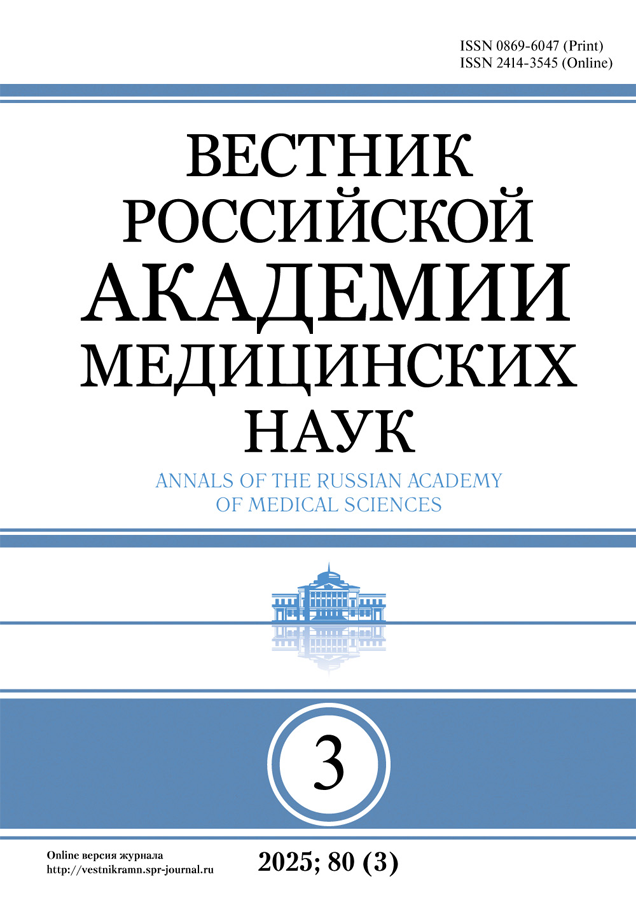ПРОГНОСТИЧЕСКАЯ ЗНАЧИМОСТЬ НАРУШЕНИЯ МАТОЧНО-ПЛАЦЕНТАРНОГО КРОВООБРАЩЕНИЯ В I ТРИМЕСТРЕ БЕРЕМЕННОСТИ У ПАЦИЕНТОК С ОТЯГОЩЕННЫМ АКУШЕРСКИМ АНАМНЕЗОМ
- Авторы: Савельева Г.М.1, Бугеренко Е.Ю.2, Панина О.Б.3
-
Учреждения:
- Российский национальный исследовательский медицинский университет им. Н.И. Пирогова, Москва, Российская Федерация
- Центр планирования семьи и репродукции департамента здравоохранения г. Москвы, Российская Федерация
- Московский государственный университет им. М.В. Ломоносова, Российская Федерация
- Выпуск: Том 68, № 7 (2013)
- Страницы: 4-8
- Раздел: АКТУАЛЬНЫЕ ВОПРОСЫ АКУШЕРСТВА И ГИНЕКОЛОГИИ
- Дата публикации:
- URL: https://vestnikramn.spr-journal.ru/jour/article/view/160
- DOI: https://doi.org/10.15690/vramn.v68i7.704
- ID: 160
Цитировать
Полный текст
Аннотация
Одной из актуальных проблем современного акушерства является ранняя диагностика нарушений в формировании маточно-плацентарной системы у пациенток с отягощенным акушерским анамнезом. Цель исследования: оценить возможность прогнозирования повторного развития акушерской патологии на основании данных допплерометрии в маточных артериях в 11–13 недель беременности. Пациенты и методы. Обследовано 410 пациенток в I триместре беременности с наличием задержки роста плода, гестоза и/или антенатальной гибели плода и/или преждевременных родов в анамнезе. Изучено влияние факторов соматического и акушерского анамнеза на состояние маточного кровообращения в I триместре беременности. Результаты. Рассчитаны оптимальные пороговые значения допплерометрических индексов. Определена высокая прогностическая способность пульсационного индекса в маточных артериях в 11-13 недель в отношении осложнений беременности с ранней клинической манифестацией, тяжелым гестозом и сочетанными акушерскими осложнениями. Выводы. Полученные нами данные подтверждают возможность доклинической диагностики акушерских осложнений второй половины беременности у пациенток с отягощенным акушерским анамнезом.
Ключевые слова
Об авторах
Г. М. Савельева
Российский национальный исследовательский медицинский университет им. Н.И. Пирогова, Москва, Российская Федерация
Автор, ответственный за переписку.
Email: gms@cfp.ru
RAMS academician, Head of the Department of Obstetrics and Gynecology, Department f Pediatrics, N.I. Pirogov Russian National Research Medical University
Address: 117997, Moscow, street Ostrovityanova, 1; tel.: (495) 718-34-72
Е. Ю. Бугеренко
Центр планирования семьи и репродукции департамента здравоохранения г. Москвы, Российская Федерация
Email: bugerenko@yandex.ru
PhD, obstetrician-gynecologist, Center of Family Planning and Reproductive Moscow Health Department
Address: 113209, Moscow, Sevastopol`sky avenue, 24-A; tel.: (499) 794-43-73
О. Б. Панина
Московский государственный университет им. М.В. Ломоносова, Российская Федерация
Email: olgapanina@yandex.ru
PhD, Professor, Department of Obstetrics and Gynecology, Faculty of Fundamental Medicine Lomonosov Moscow State University
Address: 119192, Moscow Lomonosov Ave, on 31/5; tel.: (495) 331-91-81
Список литературы
- Strizhakov A.N., Ignatko I.V. Poterya beremennosti [Pregnancy loss]. Moscow, MIA, 2007.
- Capucci R, Pivato E, Carboni S, Mossuto E, Castellino G, Padovan M, Govoni M, Marci R, Patella A. The use of uterine artery doppler as a predictive tool for adverse gestational outcomes in pregnant patients with autoimmune and thrombophilic disease. J. Prenat. Med. 2011; 5 (2): 54–58.
- Gómez O, Figueras F, Fernández S, Bennasar M, Martínez JM, Puerto B, Gratacós E. Reference ranges for uterine artery mean pulsatility index at 11–41 weeks of gestation. Ultrasound Obstet. Gynecol. 2008; 32 (2): 128–132.
- Panina O.B. Razvitie plodnogo yaitsa v I trimestre beremennosti: diagnostika i prognozirovanie prenatal'noi patologii. Avtoref. diss. … dokt. med. nauk [The development of the ovum in the I trimester of pregnancy: prenatal diagnosis and prognosis pathology. Author’s abstract]. Moscow, 2000. 32 p.
- Konovalova O. V. Tyazhelye formy gestoza. Prognozirovanie i profilaktika. Avtoref. diss. … kand. med. nauk [Severe preeclampsia. Prediction and prevention. Author’s abstract]. Moscow, 2012. 22 p.
- Pilalis A, Souka AP, Antsaklis P, Daskalakis G, Papantoniou N, Mesogitis S, Antsaklis A. Screening for pre-eclampsia and fetal growth restriction by uterine artery Doppler and PAPP-A at 11–14 weeks' gestation. Ultrasound Obstet. Gynecol. 2007; 29 (2): 135–140.
- Dugoff L., Lynch A.M. First trimester uterine artery Doppler abnormalities predict subsequent intrauterine growth restriction. Am. J. Obstet. Gynecol. 2005; 193: 1208–1212.
- Costa Fda. S., Murthi P., Keogh R., Woodrow N. Early screening for preeclampsia. Rev. Bras. Ginecol. Obstet. 2011; 33 (11): 367–375.
- Herraiz I., Escribano D., Gómez-Arriaga P.I. Predictive value of sequential models of the uterine artery Doppler in pregnancy at high risk for preeclampsia. Ultrasound Obstet. Gynecol. 2012; 40 (1): 68–74.
- Cetin I., Huppertz B., Burton G. Pregenesys pre-eclampsia markers consensus meeting: What do we require from markers, risk assessment and model systems to tailor preventive strategies? Placenta. 2011; 32 (Suppl.): 4–16.
- Khalil A, Cowans NJ, Spencer K, Goichman S, Meiri H, Harrington K. First-trimester markers for the prediction of pre-eclampsia in women with a-priori high risk. Ultrasound Obstet. Gynecol. 2010; 35 (6): 671–679.
- Rasmussen S, Irgens LM, Albrechtsen S, Dalaker K. Predicting preeclampsia in the second pregnancy from low birth weight in the first pregnancy. Obstet. Gynecol. 2000; 96: 696–700.
- Plasencia W., Maiz N., Poon L., Yu C., Nicolaides K. H. Uterine artery Doppler at 11 + 0 to 13 + 6 weeks and 21 + 0 to 24 + 6 weeks in the prediction of pre-eclampsia. Ultrasound Obstet. Gynecol. 2008; 32: 138–146.
- Martin A.M., Bindra R, Curcio P, Cicero S, Nicolaides K. Screening for pre-eclampsia and fetal growth restriction by uterine artery Doppler at 11–14 weeks of gestation. Ultrasound Obstet. Gynecol 2001; 18: 583–586.
- Melchiorre K., Leslie K, Prefumo F, Bhide A, Thilaganathan B. First-trimester uterine artery Doppler indices in the prediction of small-for-gestational age pregnancy and intrauterine growth restriction. Ultrasound Obstet. Gynecol. 2009; 33 (5): 524–529.
Дополнительные файлы








